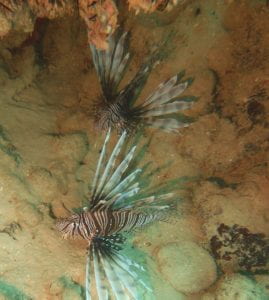The first dive I did on this trip was my check out dive which was on the eco reef right next to the marine lab. From the first looks of the dive, I didn’t have high hopes due to the wind and strong current on the surface. When we got to the sandy bottom where Snow had us do the skills for the check out, we did our mask clearing, share air drill, and regulator recovery while getting pushed along the bottom by the current. At this point we were in 13 feet of water so I still had a little hope that the dive may turn out okay. As we descended the reef, I couldn’t help but notice the mass amount of bleaching on the reef. This bleaching was different from other places I’ve dove, because the reef was bleached in small spots all over rather than large spots. As we continued the dive, we saw a plethora of parrotfish and hamlets with the most dominant species that I saw being the lionfish. Yesterday we were told that Jamaica had their lionfish population under control and within the marine lab there would be a few small lionfish, however I saw five lionfish that were some of the biggest I’ve seen in my diving career. I also saw several cleaner shrimp and brittle stars hanging around the sponges which was interesting to photograph. I maxed out at 57 feet which allowed us to also see the differentiation in the water due to a freshwater input. There were also lots more anemones and sea cucumbers then I expected to see scattered all along the reef. The only downside to the dive was that the visibility was mucked up a few times due to the number of divers diving the dive and crowding together. Overall, I would say the dive was better than I first expected with more reef than I expected Jamaica to have.
Picture of an anemone.
Picture of two lionfish under a rock.
Picture of a brittle star in a sponge.
Julia




